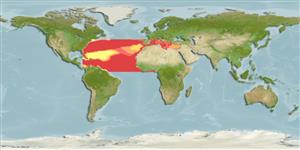Issue
This species is often confused with Nezumia aequalis (Günther, 1878).
Environment: milieu / climate zone / depth range / distribution range
Écologie
marin bathypélagique; non migrateur; profondeur 130 - 3200 m (Ref. 3587), usually 450 - 730 m (Ref. 1371). Deep-water; 43°N - 4°N, 81°W - 36°E
Atlantic Ocean: North Atlantic south to the northern part of the Gulf of Guinea in the east, into the Mediterranean Sea, and north of Straits of Florida in the west.
Length at first maturity / Taille / Poids / Âge
Maturity: Lm 15.0, range 13 - 17 cm
Max length : 36.0 cm TL mâle / non sexé; (Ref. 3587)
Épines dorsales (Total): 2; Épines anales 0. Snout short, bluntly acute; terminal scute broad, blunt; ventral surface of snout without scales posteriorly including most of suborbital, mandible mostly naked, pores prominent on head. Pyloric caeca 22 to 29. Body scales with slender, conical, slanting spinules arranged in converging rows. Color in alcohol brownish, paler on head, with violet tinge on abdomen, some silvery reflections; fins pale to blackish; first dorsal fin uniformly blackish; mouth and gill cavity mostly black.
Most numerous at 450 to 730 m in the open Atlantic and at 500 to 800 m in the Mediterranean. Feeds on small crustaceans (copepods, amphipods, decapods, mysids, etc.) and polychaetes (Ref. 1371)
Life cycle and mating behavior
Maturité | Reproduction | Frai | Œufs | Fécondité | Larves
Cohen, D.M., T. Inada, T. Iwamoto and N. Scialabba, 1990. FAO species catalogue. Vol. 10. Gadiform fishes of the world (Order Gadiformes). An annotated and illustrated catalogue of cods, hakes, grenadiers and other gadiform fishes known to date. FAO Fish. Synop. 125(10). Rome: FAO. 442 p. (Ref. 1371)
Statut dans la liste rouge de l'IUCN (Ref. 130435)
Menace pour l'homme
Harmless
Utilisations par l'homme
Pêcheries: intérêt commercial mineur
Plus d'informations
RéférencesAquacultureProfil d'aquacultureSouchesGénétiqueElectrophoresesHéritabilitéPathologiesTraitementNutrientsMass conversion
Outils
Articles particuliers
Télécharger en XML
Sources Internet
Estimates based on models
Preferred temperature (Ref.
123201): 6.3 - 14, mean 12.3 °C (based on 169 cells).
Phylogenetic diversity index (Ref.
82804): PD
50 = 0.5000 [Uniqueness, from 0.5 = low to 2.0 = high].
Bayesian length-weight: a=0.00129 (0.00077 - 0.00216), b=3.14 (2.99 - 3.29), in cm total length, based on LWR estimates for this species & (Sub)family-body (Ref.
93245).
Niveau trophique (Ref.
69278): 3.2 ±0.34 se; based on food items.
Résilience (Ref.
120179): Milieu, temps minimum de doublement de population : 1,4 à 4,4 années (K=0.10-0.16; tmax=9).
Fishing Vulnerability (Ref.
59153): High vulnerability (60 of 100).
Nutrients (Ref.
124155): Calcium = 28.8 [7.6, 70.7] mg/100g; Iron = 0.294 [0.121, 0.874] mg/100g; Protein = 16.9 [15.0, 18.7] %; Omega3 = 0.119 [0.042, 0.315] g/100g; Selenium = 22.1 [6.4, 62.2] μg/100g; VitaminA = 31.3 [3.4, 282.7] μg/100g; Zinc = 0.713 [0.371, 1.463] mg/100g (wet weight);
